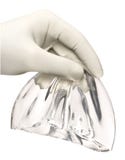More than a Decade Later, Silicone Implants Still Controversial
February 1, 2007
MOVERS AND SHAKERS 2006
|
|
Allergan's silicone breast implants gained premarket approval in 2002 after a four-year study. |
After a 14-year hiatus, silicone breast implants have been welcomed back onto the U.S. market with equal amounts of high praise and strong criticism. Implant manufacturers Mentor Corp. (Santa Barbara, CA) and Allergan Inc. (Irvine, CA) received FDA approval for their gel-filled products in November. Both companies will likely face resistance from opponents for years to come, but it isn't expected to stand in the way of their financial success.
Silicone implants were pulled from the market in 1992, amid concerns over their rupture rate and whether leaking silicone caused certain diseases, including cancer and autoimmune illnesses. After reviewing premarket approval (PMA) applications, FDA restricted silicone implants to investigational use. Only women who needed breast reconstruction or the replacement of existing silicone implants could receive the products, and they were followed via clinical studies.
During the 1990s, Mentor and Allergan (then Inamed) collected study data on silicone implants. Following updated PMA applications by Allergan and Mentor, in 2002 and 2003 respectively, FDA held panel meetings and ultimately issued approval letters.
As stated on FDA's Web site for breast implants, the agency reviewed several factors prior to approval. It examined three- and four-year data collected by Mentor and Allergan respectively, results from studies involving breast reconstructions and revisions, company lab testing data, published scientific literature, and inspections of Mentor's and Allergan's manufacturing plants.
Patient advocacy groups assert that there has never been enough data to justify approval of silicone implants. FDA also has acknowledged that patients who receive silicone implants are likely to need additional surgery, either because of rupture or “unacceptable cosmetic outcomes,” and that many of the changes to the breast following implantation are irreversible. One of the conditions of approval is that Mentor and Allergan conduct postapproval studies, following 40,000 patients each for 10 years after they receive silicone implants. The studies will collect data regarding the effects of the implants, including rates of rupture, long-term local complications, cancer, reproductive issues, connective tissue disease, and neurological disease.
|
Mentor received premarket approval in 2003 after collecting three-year study data on its silicone breast implants. |
Sidney Wolfe, MD, director of Public Citizen's Health Research Group (Washington, DC), questions the agency's use of short-term data in the approval process. “Why is it that after 14 years, [there are] no data longer than four or five years? The idea of approving first and answering questions later is reckless. Lots of women are going to get these devices, and predictably, there will be a lot of problems with them—problems that should have been identified on a long-term basis, prior to approval.” Public Citizen originally petitioned to ban silicone breast implants in 1988.
One of the problems that Wolfe is referring to is implant rupture. According to FDA, and the patient information booklets of Mentor and Allergan, most silicone breast implant ruptures are silent. This means that the rupture is likely to go undetected by a doctor, because there are no symptoms. Silent ruptures are found using magnetic resonance imaging (MRI). Device labeling states that a woman should have an MRI exam three years after silicone implant surgery and then every two years thereafter. The manufacturers also warn that insurance companies might not cover the MRI screenings.
Wolfe calls the approval a bad decision and predicts that injuries will start to mount in a few years as more women receive implants and have had them longer. “This is another nail in the coffin of the way CDRH is being run these days,” he says.
A spokeswoman from Allergan stands by the safety of silicone implants, citing their 25-year success rate in 60 countries. “Silicone breast implants are among the most studied medical devices in existence, with thousands of peer-reviewed and published reports on studies, including robust epidemiological studies to support their safe use.”
Despite safety concerns, analysts expect silicone implants to surpass their saline counterparts, as many doctors and women favor the product for its more-natural feel and appearance. Women will also find comfort in the protocol of the required FDA postapproval studies, according to Jonathan Block, vice president and senior analyst for medical devices and diagnostics at SunTrust Robin Humphrey (New York City).
Both manufacturers are expected to benefit from the reintroduction of silicone implants, but Mentor is likely to feel a stronger financial effect, because it relies more heavily on implant revenue. Block notes that 85% of Mentor's revenue is derived from breast aesthetics. “All the trials and protocols put in place by FDA are likely to cost Mentor around $40 million over the next 10 years, but it's going to open up more than $1 billion in U.S. augmentation revenue,” he says.
Block predicts that silicone implants will account for roughly 40% of augmentation procedures in the next several months, and more than 50% within the next two years. He doesn't, however, expect silicone implants to hit the 90% market penetration that is seen in Europe, because of age restrictions (women must be 22 years or older to get silicone implants) and residual apprehension in the United States. The maximum market penetration of silicone implants is expected to reach about 75% in four to five years.
Regardless of the controversy surrounding breast implants, many women are likely to select silicone implants as the product of choice. Long-term data from postapproval studies are anticipated to be the strongest factor in assessing the product's safety.
Copyright ©2007 Medical Device & Diagnostic Industry
About the Author(s)
You May Also Like




.png?width=300&auto=webp&quality=80&disable=upscale)
